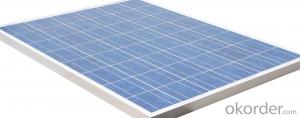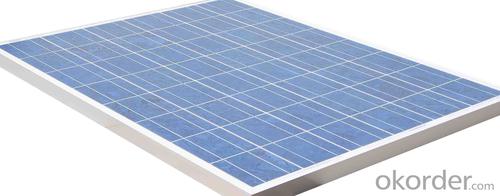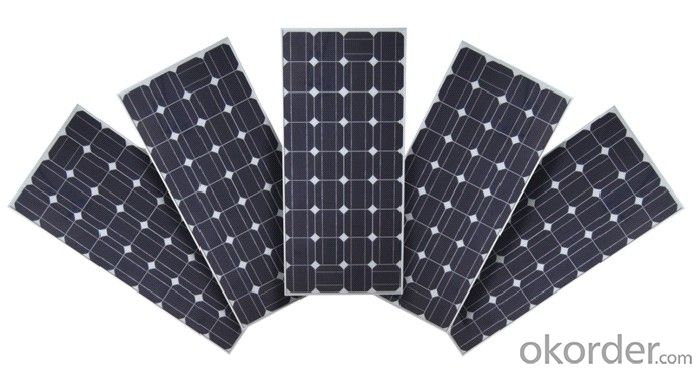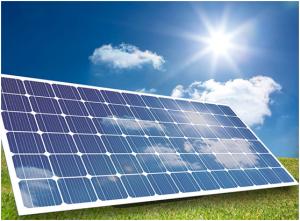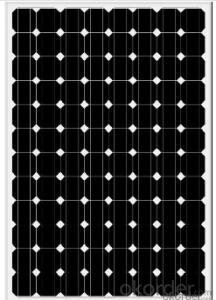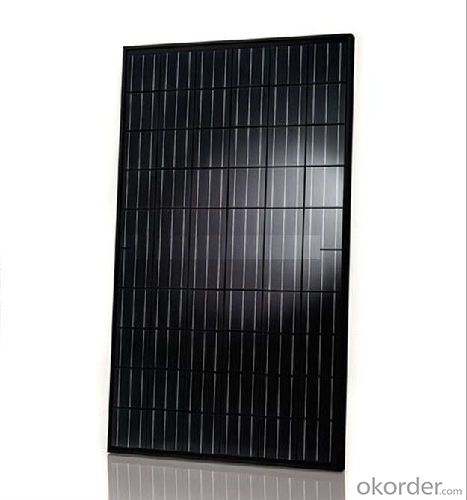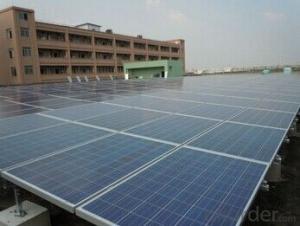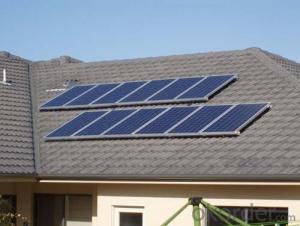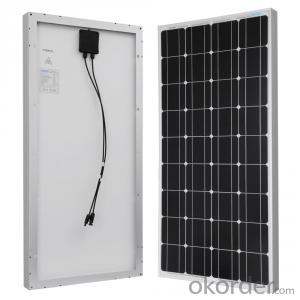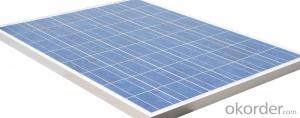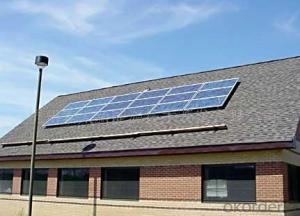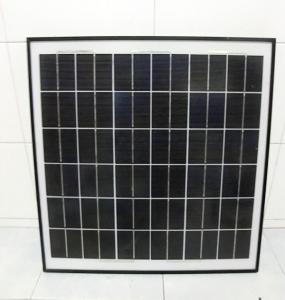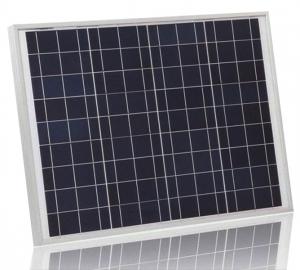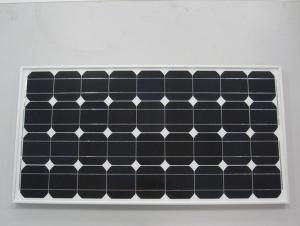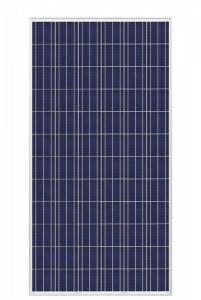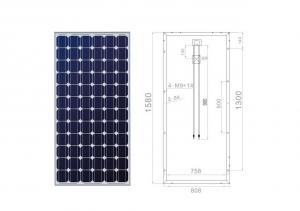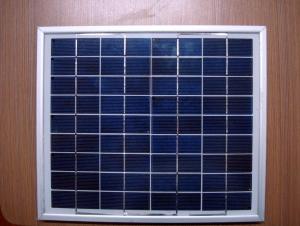Solar Panels from CdS:Photovoltaic Solar Panel in Electronic Equipment & Supplier 230W
- Loading Port:
- China main port
- Payment Terms:
- TT or LC
- Min Order Qty:
- 1 pc
- Supply Capability:
- 100 pc/month
OKorder Service Pledge
OKorder Financial Service
You Might Also Like
1.Structure of Solar Module Description
Quick Details
| Place of Origin: | Taiwan | Brand Name: | CNBM | Model Number: | TF-230 |
| Material: | Polycrystalline Silicon | Size: | 1642*992*40mm | Number of Cells: | 60pc |
| color: | Black / Dark blue |
2.Main Features of the Solar Module
Packaging & Delivery
| Packaging Detail: | 2pcs in one carton, standard export carton |
| Delivery Detail: | within 15days after received payment |
3.Solar Module Images
4.Solar Module Specification
Specifications
1)Full automatic welding equipment.
2)Quality insurance .
3)Certificate:ISO,CE,ROHS,IEC,TUV.
4)OEM accepted....
230W Solar Panel Specifications (Test condition: 1000W/m2, AM1.5, 25)
| Type Silicon Parameters | 230P | |
| Poly-crystalline silicon | ||
| Maximum Power | Watt | 230W |
| Production Tolerance | +3% /-3% | |
| Maximum Power voltage | V | 28.4 |
| Maximum Power current | A | 8.1 |
| Open circuit voltage | V | 35.6 |
| Short circuit current | A | 8.75 |
| Size of module (wide and high) | 1642mm x 992mm x 40mm | |
| Frame (type, material and thickness) | Anodized Alu. Alloy frame,40mm thickness | |
| Number of cells | 60pcs | |
| Size of cells (wide and high) | 156mmx156mm | |
| Weight per piece Kg | 24 | |
| Type of junction box | PV junction box | |
| Cable type and length, Connector type | PV cable, 0.8m Plug and socket | |
| Maximum system voltage | 1000V | |
| Temperature coefficient of Isc | +0.05%/oC | |
| Temperature coefficient of Voc | -0.34%/oC | |
| Temperature coefficient of power | -0.45%/oC | |
| Temperature coefficient of Im | +0.05%/oC | |
| Temperature coefficient of Vm | -0.34%/oC | |
| NOCT (Nominal operating cell temperature) | 47oC(+2oC) | |
| Insulation | >=100 MΩ | |
| Voltage Standoff | AC2000V, DC3000V | |
| Wind Bearing | 60m/s (200kg/sq.m) | |
| Impact Resistance Hail Impact Test | 227g steel ball fall down from 1m height | |
| CONVERSION EFFICIENCY | Cell CONVERSION EFFICIENCY >15.7% | |
| Quality guarantee | 5 years product warranty and 25 years -20% of power | |
5.FAQ of Solar Module
1. Q: Do you have your own factory?
A: Yes, we have. Our factory located in Jiangyin city, jiangsu province.
2. Q: How can I visit your factory?
A: Before you take off from your country, please let us know. We will show you the way,or arrange time to pick you up if possible.
3. Q: Could you print our company LOGO on the nameplate and package?
A: Yes, we can do that.
4. Q: Do you accept custom design on size?
A: Yes, if the size is reasonable.
- Q: How can I determine the size of solar panel system I need?
- To determine the size of the solar panel system you need, you should consider factors such as your energy consumption, available roof space, and geographical location. Start by analyzing your average monthly electricity usage to estimate the amount of energy your solar panels should produce. Next, assess your roof's orientation, tilt, and shading to make sure it can accommodate the necessary number of panels. Lastly, consider your location's sunlight hours and climate conditions, as they affect the efficiency and output of solar panels. Consulting with a professional solar installer can also help you accurately determine the size of the solar panel system you need.
- Q: Can solar panels be used for powering a marina or boating facility?
- Yes, solar panels can be used to power a marina or boating facility. Solar energy can provide a reliable and sustainable source of power for various applications such as lighting, charging stations, refrigeration, and other electrical needs in a marina or boating facility. By harnessing the sun's energy, solar panels can significantly reduce dependency on traditional electricity sources, lower operating costs, and promote environmental sustainability.
- Q: Can solar panels be connected directly to motor?
- The sun is irradiated on the semiconductor p-n junction to form a new hole-electron pair. Under the action of the p-n junction electric field, the holes flow from the n region to the p region. The electrons flow from the p region to the n region, and the current is formed after the circuit is turned on.
- Q: I have a home in Manchester Tn and we have been slowly remodeling the home. It is about 200 sq ft of living space. Our normal electric bill is about 50 a month. We would like to add some solar panels to the home to help reduce the amount of the bill. How many panels do I need and what would be the cost? I am not trying to go completely of the grid but I would like to start somewhere and maybe over the years be able to add. What is your recommendation for a reasonable cost of under 2 to 3 k??
- you need to read and ? your elect co they will help you with survey of your elect use and how to lower bill . for free also read about solar panels and how to use and install bg makes good panels but panels only small part of cost invertor and controler and batterys bigger cost the real expense is panel and controler for panels to to grid connection as per nec is very expensive more than 2 for most 00 or 200 amp service you would better to change to demand type warer heater and flouresent lights and upgrade isullation depending on how you heat house and your area heat pump etc but call your elect co for engergy survey
- Q: If my school uses 88240kWh of electricity per month and I have 000 50W solar panels running for 6 hours a day, does it mean it will take 88240kWh / {{[(50W x 3600s)*000]/000}kWh x 6} number of hours to generate that much electricity (88240kWh)?
- your first question: Does a 50W solar panel generate 540kWh? 540 kW-hr / 50W = 3600 hours it would take that long for the panel to generate that amount of energy. your second question is confused, as you both stipulate the number of hours at 6 hours per day, and you try to solve for the number of hours. 000 x 50w = 50 kW 50 kW x 6 hr/day x 30 day/mo = 27000 kW-hr/mo = 27 MW-hr/mo that is the amount of energy generated. That is nowhere close to 88240 kWh or 88 MW-hr. I would take 7 times more solar panels to generate that much energy. .
- Q: Can solar panels be installed on rooftop gardens or green roofs?
- Yes, solar panels can be installed on rooftop gardens or green roofs. In fact, combining solar panels with green roofs can provide numerous benefits such as maximizing energy efficiency, reducing heat island effect, and enhancing biodiversity. It's a sustainable and innovative approach to utilize rooftop spaces for both renewable energy generation and environmental conservation.
- Q: How do I choose the right size of solar panels for my home?
- To choose the right size of solar panels for your home, you need to consider the available roof space, your energy consumption, and your budget. First, assess the area on your roof that can accommodate solar panels and determine its orientation and shading. Then, calculate your average monthly electricity usage to estimate the system size required to meet your needs. Lastly, take your budget into account and consider the cost-effectiveness of different panel sizes. Consulting with a solar professional can also provide valuable guidance in determining the right size for your specific requirements.
- Q: Solar panels are expensive,can I make my own solar panel?
- Have okorder . This could definitely help you!
- Q: about solar panel
- The answer depends upon the type of solar energy captured . Photovoltaic Solar Panels convert the energy into electricity. This electricity is ran throughout the building via wires. Thermal Solar Panels typically capture the energy in the form of heat. The hot water is circulated through the building in water pipes.
- Q: And how do you choose the best one for the best price?I saw a 400 watt monocrystalline solar panel
- In regards to my research about these two types of Solar Panels, I suggest that the Monocrystalline Solar Panel would be great! It is affordable and also more convenient to install. Using a 400W Panel means fewer panels and less installation time, in addition to fewer connections and transmission losses which results in big savings and a faster return on your investment.The Topsun Solar Panels boasts efficiency of up to 6.77% and use cutting edge technology for the best heat dissipation in the industry.
Send your message to us
Solar Panels from CdS:Photovoltaic Solar Panel in Electronic Equipment & Supplier 230W
- Loading Port:
- China main port
- Payment Terms:
- TT or LC
- Min Order Qty:
- 1 pc
- Supply Capability:
- 100 pc/month
OKorder Service Pledge
OKorder Financial Service
Similar products
Hot products
Hot Searches
Related keywords
